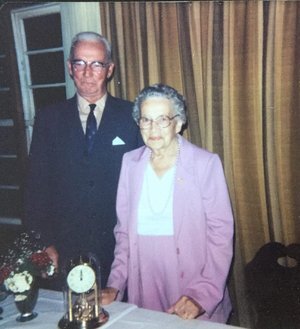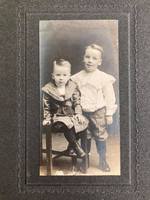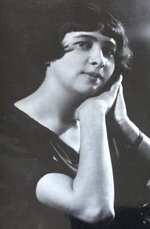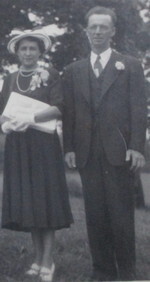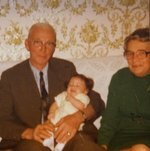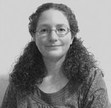[DRAFT] Lyman Porter Knowlton and Elsie Maud Davidson
Lyman Porter ‘Buster’ Knowlton and Elsie Maude Davidson
Among his two surviving brothers, Lyman Porter Knowlton (also known as Buster) inherited the family farm. He was born December 12, 1905, to Lyman Potter Knowlton and Hattie Cleveland. He was educated at the Coolidge school and worked on several different farms as well as his family’s. Porter was baptized into the Methodist church on March 22, 1920.
With so many brothers to share the work on the family farm, Porter managed a farm in Bolton Center (according to his nephew Clifford Young) and later worked Errol Marsh’s farm in Iron Hill. He was also a part of the Harvest train that took young men west to Saskatchewan to work the farms during the summer.
Porter married Elsie Maud Davidson (19 AUG 1903–7 NOV 1993) June 26, 1926, in Knowlton (present day Lac Brome). Elsie was one of twelve children that Alfred Davidson and Maud Proulx raised in Davidson Hill until 1916. Elsie described her home in a 1915 column in the Sherbrooke record “I live on a farm. I like it very well. We have five horses, twenty-two cows and four calves. We have seventeen sheep, also I had a pet lamb last summer.”
In 1917, Elsie lived with her grandparents, Margaret Davidson and Jeremie Proulx, in South Dunham to attend school. Elsie took a short course for an elementary school diploma at MacDonald College (Montreal) in 1921 and taught school at Davidson Hill (1921-1922), Val Perkins (1922-1926), and Coolidge school (1942-1952). Elsie and Porter’s courtship began during her tenure at the Val Perkins school.
Porter and Elsie lived at Mr. Marsh’s Iron Hill farm early in their marriage. It wasn’t until Elsie was due to give birth to their first child Ralph Frederick Sr. (born November 14, 1926) that the couple returned to Knowlton Landing. Porter continued working at the Marsh farm where the new family occupied an apartment in the main house according to Tony Marsh (Errol Marsh’s grandson). The Marsh farm was a mixed farm with brood sows, hens and cattle. After Porter’s brother Fern left to work in Montreal around 1929, Porter returned to Knowlton Landing to work on the family farm. Porter and Elsie had two daughters, June Elaine Knowlton (1928–1997), who married Howard Clay Jewett (1927–2012), and Doris Jean Knowlton (1929–2020), who married Ralph George Perkins (1924–2003).
Porter served on the Brome County Agricultural Society board as president in 1964 and was a part of various committees. At the annual Brome Fair, Porter and Elsie won numerous prizes for their maple syrup and syrup products in addition to Elsie’s flowers. Elsie was also a member of the Knowlton Landing branch of the Women’s Institute, a charitable organization that raised money for local needs, such as bursaries and Christmas gifts, as well as UNICEF.
Elsie taught for 10 years at the Coolidge school. Her recollections of her years teaching were written up in a local paper:
The school house had only one room. In the room there was a teacher’s desk, students’ desks, a cupboard for dishes, shelves for library books and a box stove. Wood for the stove was kept in an attached woodshed. Also in this woodshed there was a toilet.
The twelve to twenty children who came to school were in grades one to seven. They arrived at nine o’clock and stayed until three thirty. After hanging their coats on a nail in the classroom, they took their lunch pails to their desks.
Each child sat in an individual wooden desk which had a pullout drawer on the side to hold books. On the top of the desk there was an inkwell which was used to hold ink for fountain pens. Mrs. Knowlton taught all subjects to each grade — French, Reading, Arithmetic, History, Spelling, Scripture, Geography, Literature, Handwriting and Art. With seven grades in the same room, the teacher was busy! She taught one grade while the other students did copying from the blackboard, workbooks or studying. Students had to stay in their desks. If they needed to see the teacher at her desk, they raised one finger. If they had to go to the bathroom, they raised two fingers.
The morning began by saying the Lord’s Prayer. Next the children saluted the Union Jack, which was Canada’s flag at this time.
Mrs. Knowlton played the organ and sang hymns with the children. At recess time the children talked, played tag, baseball and hide and go seek. Sometimes the teacher stayed inside with students if they were being punished or she corrected work. Friday afternoons were special. Students got to choose what they wanted to do. Some chose coloring or reading from library books which were in the classroom.
On chilly days and in the winter time a parent started the fire before school. During the day the teacher kept the fire going. The stove was used to dry out wet clothes. It was also used to warm up hot lunches for the children. Parents took turns sending food like soup, beans and scalloped potatoes to school. The teacher warmed up the food and the children took turns washing the dishes. Mrs. Knowlton smiled when she remembered that “sometimes the boys washed dishes better than the girls.”
On the farm, Lyman Porter Knowlton oversaw 30-36 Jersey milking cows, 10-12 sows, and 25-30 finishing hogs in addition to selling wood and maple syrup. Peter Talbot recalled a memorable trip to Brome Fair riding in the back of a truck with Lyman Porter Knowlton and two grown sows. The entire hog operation was lost in a barn fire in 1976. Two years prior, Porter had deeded the farm to his son, Ralph Knowlton, Sr. However, Porter would often make trips to the sugar house well into his seventies to personally inspect each year's production by sampling a cup of hot syrup fresh off the evaporator.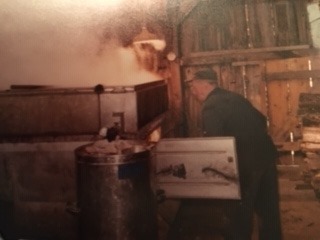
Later in life, Porter and Elsie were active members of the Golden Age Club and ardent bingo players, attending games several times a week and often returning home with door prizes for their great-grandchildren. Elsie died in 1993 and Porter in 1997. Their obituaries are a tribute to their lives and contributions to their family and communities:
“She was a quiet, gentle, kind and loving person and was known near and far for her “green thumb” in raising many African Violets for others to enjoy, as well as her love and care for her outside flower gardens. In earlier years, she enjoyed knitting, crocheting and rug making. In later years, she did crossword and jig-saw puzzles, read and exchanged books with friends and particularly enjoyed going to the local bingo games. She was a member of the former I.K. Club and the W.I. and also worked in the maple products department at Brome Fair for many years as well as being a faithful member of the local Golden Age Club.”
“Porter was well known for his love of the land, working it first with horses, which he loved to drive and take care of. Then in later years with tractors and more modern machinery. He loved children, he could be seen in younger years with scads of kids accompanying him as he delivered ice, milk and wood to the cottage people. His herd of jersey cows was his pride and joy and he delivered milk to the Magog Diary of which he was a member and shareholder for many years. Porter was President for a time, director, faithful worker of the Brome County Agricultural Fair, as well as exhibitor of maple products and winner of prizes in that department. He served on the Municipality of Potton Council for years and was always willing to lend a hand to those in need.”
I was fortunate enough to spend much of my childhood and adolescence on the farm and knew my great-grandparents. Grammy Elsie took in my plants when I had to move away. I remember chatting with her in her kitchen with the wood stove or sitting in her sunroom surrounded by plants. Grampy Porter kept a tin of Oreos on the kitchen table and would always offer the great-grandchildren one when we visited. Their house was a mystery to me with secret stairways and unused upstairs bedrooms that fascinated me. Grampy Porter would sit on his porch in the summer after he’s swept his driveway, swatting at flies and watching everyone going by. In the winter, their big dining table became a puzzle table covered in thousands of puzzle pieces.
My mother often recalled to me how Porter would help to put the syrup into containers. He was notorious for sipping off whatever syrup overflowed.
One summer, my brother and I spent two days striping and re-painting their big wrap-around porch. When the task was completed, Porter offered us $20 to split. Elsie took me aside and gave us another $20 dollars.
Just off the large porch was a huge butternut tree that reached out over the roof. Squirrels routinely stole the nuts and hid them everywhere. My great-grandfather was forever in a battle to keep them out of the attic. He would take aim at them with his rifle even with failing eyesight that left the squirrels unharmed and his car tire flat.

